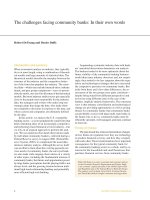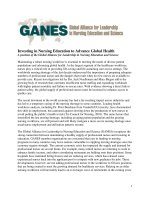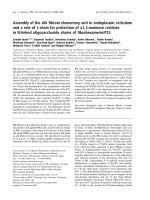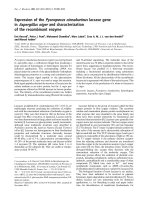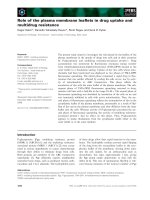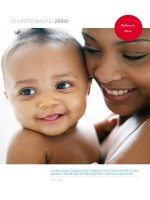assessment of the effectiveness of community interventions in management of acute respiratory infections among under-five-children in dan phuong and ba vi, ha noi
Bạn đang xem bản rút gọn của tài liệu. Xem và tải ngay bản đầy đủ của tài liệu tại đây (270.83 KB, 25 trang )
1
INTRODUCTION
Acute respiratory infections (ARIs) are the first cause of diseases’
burden and the third cause of death among under-five-children in
Viet Nam. Delays in access to health services and inappropriate
treatment are the two main reasons causing deaths for children with
ARIs. From 1982, the Global Programme for Control of Acute
Respiratory Infections, with Viet Nam being a member has been
implementing many interventions mainly focusing on the public
health care system. After many years of implementation, the
mortality rate is decreased but incidences remain high. Unsafe drug
use for treatment of ARIs is common.
Among
many
interventions,
InformationEducationCommunication (IEC) to provide knowledge, skills in care of ARI
children has always been the first approach recommended by the
World Health Organization (WHO). Coverage, targets of IEC are not
only limited to the health system but expanded to other people such
as care takers and drug sellers.
In Viet Nam, few research studies have been implemented to
explore IEC methods that are effective for prevention and control of
ARIs among under-five-children. Particularly, there was a lack of
pilot studies carrying out interventions targeting a wide range of
subjects aiming at major changes in all steps of the care-taking cycle
for children with ARIs.
We conducted the study: "Assessment of the effectiveness of
community interventions in management of Acute Respiratory
Infections among under-five-children in Dan Phuong and Ba Vi,
Ha Noi" with the following 3 objectives:
1. To assess effectiveness of interventions in changing knowledge,
practice of mothers in management of ARIs among under-five
children in Dan Phuong and Ba Vi from 2005 to 2008.
2. To assess effectiveness of interventions in changing knowledge,
practice of health providers in management of ARIs among underfive children in Dan Phuong and Ba Vi from 2005 to 2008.
3. To assess effectiveness of interventions in changing knowledge,
practice of drug sellers in drug retail for under-five children with
ARIs in Dan Phuong and Ba Vi from 2005 to 2008
2
New contributions of the study
1. This study has designed, implemented community based
interventions effective in changing knowledge, practice in care of
children with ARIs in rural areas with its targets being also people
who established and implemented the interventions. Beside the
benefits of having utilized available resources, community
participation also improve activeness and responsibility of
beneficiaries towards family and community health.
2. The interventions differed from many other preceding studies in
having targeted all three main groups related to, and having an
impact on the whole care taking cycle for children with ARIs.
3. This study was able to select and focus interventions on priority
issues according to the needs of the target groups without having to
be spread over all contents.
4. To improve effectiveness, the study selected a combination of
many IEC approaches (home communication, groups meetings,
during consultations, selling of drugs, skills training, etc.) and many
forms of supervisions (within and between groups and from higher
levels) to create an intervention package.
5. The study has successfully assessed effectiveness in measuring
changes in knowledge, practice of target groups of interventions,
thereby provided evidence that combining IEC interventions with
support supervision and active participation of target groups will
achieve high effectiveness, be suitable and sustainable.
Structure of the dissertation
The dissertation consists of 141 pages not including annexes, has
4 chapters, 33 tables, 8 figures, 142 Vietnamese and international
references and annexes. The dissertation includes: Introduction (2
pages); Overview (26 pages); Study subjects and methodology (25
pages); Results (42 pages); Discussions (42 pages); Conclusions (2
pages); Recommendation (1 page).
3
CHAPTER 1. OVERVIEW
1.1. Incidence and mortality of ARIs
In Viet Nam, ARIs are the leading cause of new infections and
deaths among under-five-children with an estimated 30 to 80 million
cases of all types of ARIs each year. ARIs have the highest
prevalence in hospitals. Among causes of childhood mortality,
pneumonia has the highest percentage.
1.3. The situation of mothers’ care for children with ARIs
Even though knowledge has been improved, mothers’ skills in
recognizing signs of diseases still have shortcomings. In 2008, in
Viet Nam, the percentage of mothers recognized signs of ARIs were
low: 5.0% for inability to drink, 4.1% for seizures and 3.4% could
recognize abnormally sleepy. For the 2 characteristic indicators of
pneumonia, only 37.3% recognized breathing signs and 0.9% knew
signs of chest indrawing.
Many skills in seeking health services for children with ARIs
needed improvement. In 2000, only 86% of parents believed that
pneumonia was a dangerous disease requiring consultation at health
care services. In 2003, the highest percentage (20.9%) was mothers
providing home care for children with ARIs. Lack of knowledge on
signs and management of diseased children has contributed to high
risks of death among children with ARIs. Among the death cases,
5.3% children with ARIs were brought to health centers in lifethreatening conditions, 39.2% with severe disease and 26.1% of the
children already died at home.
The objectives of Viet Nam’s ARI program are to reduce the rate
of incidence of ARIs and safe use of drugs for children with ARIs.
The widespread retail of antibiotics, lack of controls together with
lack of knowledge in drug use has been hindering the program.
Antibiotics abuse for mild ARIs as well as insufficient dosage,
inappropriate types of antibiotics used were common.
The practice of home care for children also was inappropriate.
For children having diseases, 67.4% of mothers knew to give more
tasty foods, 56.8% knew to keep the children warm in winter and
4
cool in summer. Only 54.6% knew to provide more to drink. Making
the airway free was the method that the least mothers knew (23.8%).
Factors related to knowledge and skills of mothers included:
severity of disease and income was related to selection of health
services. Comfort (29.0%) and proximity to home (27.1%) were most
important factors in selection of health facilities, good quality ranked
as third factor. Mass media channels were most important sources
providing information to mothers. For rural women, commune health
staff and local loudspeakers played very important roles.
Misperceptions of users were related to inappropriate drug use.
1.4. The situation of management of ARIs by health staff
Even though the ARIs program covered 100% of communes and
districts in the whole country, skills of commune health staff in
examination and diseases classification are still having shortcomings.
Health staff very often did not explore all signs of severe diseases.
Skills in counting respiratory frequency were less than required. The
percentage of health staff correctly differentiated diseases was
approximately 80.4%. Knowledge and practice of private providers is
also in need of improvement. Only about 77.5% of private physicians
knew that chest indrawing was a sign of severe pneumonia. Overuse
of antibiotics, prescriptions of inappropriate types or insufficient
dosage of antibiotics was main findings in the study on use of drugs
for ARIs treatment. The percentage of children using antibiotics for
treatment of non-pneumonia conditions was still high, accounting for
39%. In 2004, prescriptions of 2 antibiotics or more accounted for
11% and 20% of antibiotics used were injections. Health staff rarely
counsel patients on home care. Very few of mothers (5.6%) who
brought their children to physicians’ examination were counseled on
use of drugs at home. In 2008, 31% of mothers bringing their
children to examinations receive any information from the health
staff. Lack of training, not suitable treatment regimens, work
overload and profit-related factors had negative impacts on the
practice of health staff.
1.5. The situation of drug retail for children with ARIs
Inappropriate, unsafe selling of drugs is increasing. Drugs are
sold freely on the market, without instructions, even without
5
prescriptions, including those requiring physicians’ indications. A
large majority of children (91%) having ARIs received antibiotics.
Among those decided to use antibiotics, 67% households did so by
following suggestions of drug sellers, 11% decided by themselves
and only 22% followed physicians’ prescriptions. This means that
people have the risks of using drugs for wrong indications,
ineffective use, or even having health risks.
Professional practice skills of private pharmacies’ staff are
affected by many factors such as: professional knowledge, buyers’
demand, regulatory documents and profits.
1.6. Interventions to change behaviors in care of ARIs children
Because of IEC efforts combined with other interventions,
prevention and control of ARIs has achieved promising results. Some
studies have suggested the need to implement interventions to change
behaviors of all subjects related to the care taking cycles for sick
children.
There have been only few studies providing IEC interventions
for mothers. Pilot interventions included: health staff providing direct
communication for mothers groups, video instructions at commune
health stations, educational messages on commune loudspeakers.
Contents of IEC messages were usually provided by professionals.
For health staff, there were pilot interventions with lower level
health staff constructing treatment regimens for themselves to be
more suitable to local conditions but they did not have high
effectiveness due to lack of on-site self-supervision or peer
supervision. Training of lower level health staff at higher levels also
was not effective because of differences in diseases patterns and
conditions between different levels.
For drug sellers, interventions focused on the practice of drug
retail and counseling on appropriate use of drugs for some diseases
including ARIs but the few interventions were in urban areas only.
CHAPTER 2. LOCATION AND METHODS OF THE STUDY
2.1. Study subjects
Mothers having a child under five (who were mothers having a
child less than three years old at baseline survey, were followed for 2
6
years until study ended); health staff and drug sellers at commune
health stations and private providers in selected communes.
2.2. Location
Dan Phuong and Ba Vi districts, Ha Noi (formerly Ha Tay province).
2.3. Duration of the study
From March 2005 to January 2008, wherein interventions were
carried out in a two-year period.
2.4. Terms, definitions used in the study
2.5. Study methods
2.5.1. Study design
Community based intervention study with control.
2.5.2. Sample size
2.5.2.1. Mothers
Using formula for sample size to compare two proportions:
{z
n=
1−α / 2
2 p (1 − p ) + z1− β
p1 (1 − p1 ) + p 2 (1 − p 2 )
( p1 − p 2 ) 2
}
2
Where: n: minimal sample size (number of mothers); p1=46.2%;
p2=60%; p =(p1+p2)/2 ; Z1-α/2=1.96 with α=0.5%; Z1-β=0.84 (β=80%).
The calculated sample size was 157 (each group). To ensure
sufficient sample for analysis, a sample of 300 was selected for each
group, giving a total of 600 mothers.
2.5.2.2. Health service providers
Enrolment of all health providers (commune stations and private)
and drug sellers in communes receiving interventions for mothers.
2.5.3. Sample selection
- Multi-stage sampling was used. After the baseline, two districts
were randomly selected to be intervention and control districts.
- Random selection of 5 out of 10 similar commune pairs.
- Random selection of 3 villages in each commune for the study.
- All mothers having a child under 3 year old were selected for
follow-up during the two-year-intervention and assessment after
interventions (at a time all had their children under 5 years). After 2
years, with exception of few withdrawals and a few children
exceeding the age of five, analysis before and after interventions
included 625 mothers (301 in Ba Vi and 324 in Dan Phuong).
7
- Enrollment of all health providers and drug sellers in selected
communes.
2.5.4. Data collection methods
2.5.4.1. Techniques, tools for quantitative data
- Mothers were directly interviewed using questionnairre. All
mothers were assessed for knowledge. Practice of mothers whose
children had ARIs within 2 months before surveys were assessed.
- Health providers were interviewed for knowledge and observations
were made using checklist for their practice.
- Drug sellers were assessed for knowledge using direct interview
and for practice by drug buyers’ observations using checklist.
2.5.4.2. Techniques, tools for qualitative data
In each district, before and after interventions, focus group
discussions were made with mothers, active mother groups, health
providers, drug sellers, and managers.
2.5.5. Methods used to control biases
2.5.6. Data management methods
Quantitative data were entered using Epi-DATA and analyzed
using STATA to calculate percentages, means, test for hypotheses
and EI (Effectiveness Indicators).
Qualitative data were managed “ open-coded” by groups of themes
and cited in the report.
2.6. Design and implementation of interventions
Interventions were carried out in 5 selected communes in Ba Vi
with IEC activities during 12 months and support supervision for the
next 12 months. Steps of implementation included:
- Designing intervention materials: “Child health diary” for the
mothers, treatment instructions for health providers and drug selling
instructions for drug sellers.
- Implementation of IEC interventions for mothers (counseling
provided by active mothers, group meetings, counseling during
consultations and drug purchase) and skills training for groups
providing health services.
- Supervision (from higher level, between and within groups) for
changing practices and monitor sustainability.
2.7. Ethical issues
8
CHAPTER 3. RESULTS
3.1. Effectiveness in changing knowledge, practice of mothers in
taking care of children with ARIs.
3.1.1. Some characteristics of mothers
Average age was 27.6±4.9. Mothers in agriculture and having
secondary school attainment had the highest proportions. There was
no significant difference in average age, occupations, educational
attainment and households characteristics between two groups.
3.1.2. Effect of interventions on mothers’ knowledge
3.1.2.1. Recognition of signs of diseases
The distribution of mothers by number of diseases signs they
could recognize post-intervention (PI) differed from baseline (BL)
significantly.
Table 3.3: Comparison by number of signs mothers knew indicating
need for examination baseline-post intervention (%)
Number of
signs
No sign
1 sign
2 signs
3 signs
4 signs
5 signs
6 signs
Intervention
BL
PI
p
n=301 n=301
11.6
0.3 <0.001
29.2
4.0 <0.001
32.6
9.6 <0.001
22.3
18.9 <0.001
3.7
39.5 <0.001
0.3
21.7 <0.001
0.3
6.0 <0.001
Control*
BL
PI
n=324
n=324
13.9
13.3
34.6
31.5
29.6
30.2
17.3
17.0
4.3
6.5
0.3
1.5
0
0
EI
-93.1
- 77.3
-72.6
-13.5
915.9
7729.0
1900.0
* No significant difference for any indicator among control group
At baseline, intervention group knowing two signs accounted for
the highest percentage (32.6%). Post-intervention, mothers knowing
4 signs had the highest percentage (39.53%).
3.1.2.2. Knowledge on management of sick children
The percentage in intervention group knowing to bring the child
for exams when there are signs indicating such a need increased from
13.8% to 93.0% (p<0.05). The percentage of mothers correctly
knowing children can be monitored at home increased to 23.9% in
the intervention group as compared to 1.3% at baseline (p<0.001).
9
Table 3.5: Comparisson of knowledge on management of children with
ARIs of mothers baseline-post intervention (%)
Intervention
Control*
Management
BL
PI
p
BL
PI
n=301 n=301
n=324 n=324
If the child has signs indicating need for examination
Seek exam
73.8
93.0
<0.05
75.6
80.8
19.1
If the child has cough, cold
Seek exam
50.2
53.2
>0.05
48.5
49.4
46.6
Monitor at
1.3
23.9
1.0
2.1
home
<0.001
1837.3
Correct
51.5
77.1
49.4
51.5
management
<0.001
45.4
* No significant difference for any indicator among control group
3.1.2.3. Knowledge on drug use
Table 3.6: Comparison of mothers' knowledge on the use of antibiotics for
children with ARIs, baseline-post intervention (%)
Intervention
Control*
Antibiotics use
BL
PI
p
BL
PI
n=301 n=301
n=324 n=324
With
prescription
62.8
94.4 <0.001
55.2
58.0
45.2
Sufficient
39.2
70.1 <0.001
47.8
42.6
91.1
duration
No antibiotics
for cold
49.5
63.8
<0.05
50.0
47.5
33.8
* No significant difference for any indicator among control group
All 3 indicators for knowledge on antibiotics use of mothers postintervention in Ba Vi significantly increased in comparison to
baseline and were much higher than among controls as well.
3.1.2.3. Knowledge on care, follow-up of children
Post-intervention, the percentage of mothers having correct
knowledge on child care for each indicator increased by about 20%
or more. All four indicators increased significantly.
Post-intervention, the percentage in Ba Vi knowing needs for
monitoring of children increased by 16.8% with statistically
significant differences. Knowledge on re-examination (immediate
and scheduled) also increased significantly.
10
Table 3.7: Comparison of mothers’ knowledge on child care and monitoring,
baseline-post intervention (%)
Care,
Intervention
Control*
BL
PI
Monitoring
EI
p
BL
PI
n=301
n=301
n=324 n=324
More foods
59.1
79.7
<0.05
67.3
71.6
28.4
More fluids
55.5
74.4
<0.05
64.2
59.6
41.3
Make free airway
47.2
69.1 <0.001
48.1
48.5
45.9
Keep warm/cool
Follow-up
60.7
39.2
96.0
57.8
<0.001
<0.01
67.0
41.4
72.2
37.4
50.4
51.5
* No significant difference for any indicator among control group
3.1.3. Effects of interventions on mothers’ practice
3.1.3.1. Practice in management of sick child
Table 3.8: Comparison of mothers’ management of children having signs
indicating need for exams baseline-post intervention (%)
Management
Intervention
Control*
EI
BL
PI
p
BL
PI
n=27
n=38
n=25
n=21
Seek exams
74.1
92.1 <0.001
57.1
68.0
5.2
* No significant difference for any indicator among control group
Post-intervention, most of the intervention group (92%) brought
children to examination upon detection of signs of severe disease in
need of examination (p<0.001) (Table 3.8).
Figure 3.2: Comparison of practice for children with cough, cold at
baseline and post-intervention (%)
For children having cough, cold, the percentage of mothers in Ba
Vi with correct management significantly increased as compared to
baseline. Main reason for the increase was an increase of those who
follow their children at home by 14.7% compared to baseline with an
EI of more than 472.4% (Figure 3.2).
11
3.1.3.2. Practice of drug use
Table 3.9: Comparison of mothers’ antibiotics use practice for
baseline-post intervention
Intervention
Control*
Antibiotics
BL
PI
p
BL
PI
use
n=178 n=113
n=172 n=160
With
prescription
53.4
70.8
>0.05
50.0
53.1
Sufficient
25.3
63.7 <0.001
33.1
41.9
duration
Both
18.0
47.8 <0.001
19.8
24.4
children
EI
26.4
125.2
142.2
* No significant difference for any indicator among control group
There was a positive change in antibiotics use among the
intervention group. The percentage using antibiotics with prescription
and for sufficient duration increased from 18.0% to 47.8% (p<0.001)
with an EI of interventions reaching 142.2%.
Table 3.10: Comparison of drugs buying practice for children with cough,
cold baseline-post intervention (%)
Intervention
Control*
EI
BL
PI
p
BL
PI
n=98 n=53
n=85
n=87
No antibiotics
16.3
28.3 >0.05
27.1
24.1
84.5
* No significant difference for any indicator among control group
For cough and cold, the percentage of mothers with correct
practice post-intervention in Ba Vi increased but not significantly.
3.1.3.4. Practice in care, follow-up of children
Table 3.11: Comparison of mothers’ practice in child care baseline-post
intervention
Intervention
Control*
EI
Care, Follow-up
More foods
More fluids
Make free airway
Keep warm/cool
Monitoring
BL
n =211
28.9
33.2
24.6
PI
n =198
54.4
53.8
32.8
P
<0.001
<0.001
<0.05
BL
n =171
38.0
38.0
33.3
46.4
59.1 <0.001
47.4
32.7
40.9
>0.05
49.1
* No significant difference for any indicator among control group
PI
n=189
29.6
32.3
31.2
110.2
68.8
33.9
45.0
51.9
50.6
19.4
12
Post-intervention, the percentage who did each of the essential
care tasks at home clearly increased, with the exception of indicator
for monitoring which increased but not significantly.
Post-intervention, the percentage of mothers bringing their
children to re-examination after 2-3 days of antibiotics use increased
to 38.2% (p<0.001). Intervention EI was 599.4%.
3.2. Effects of interventions in changing providers’ knowledge,
practice in care of children with ARIs.
3.2.1. Characteristics of health providers
Two groups of providers in two districts had similarity in some
basis characteristics such as age, years in occupation, professional
level, and types of health facility (private /public). There was no
statistically significant difference between two groups in above
mentioned data. Average age was 40. The majority (74.68%) were
assistant doctors. The number of private providers was twice as high
as commune health station staff. The majority provided examination
and treatment for more than 10.
3.2.2. Effectiveness in changing providers’ knowledge
3.2.2.1. Knowledge to recognize signs of diseases
For very severe diseases, providers need to remember 11 signs (6
for children under 2 months of age and 5 for children from 2 months
to 5 years). At baseline in both districts, most providers only
remembered between 4 and 6 signs. A few did not know any. No
provider remembered all signs. Post-intervention, most providers in
Ba Vi knew from seven to nine signs, no one knew less than 4 signs
and 11% knew all 11 signs.
Table 3.13: Comparison of providers’ knowledge on signs of severe
pneumonia baseline and post-intervention (%)
Signs of severe
Intervention
Control*
pneumonia
BL
PI
p
BL
PI
n=36
n=36
n=43
n=43
Children under 2 months
Chest indrawing
55.6
88.9
<0.01
67.4
72.1
Fast breaths
55.6
100
>0.05
53.5
55.8
Raised resp. rate
41.7
88.9
>0.05
41.9
39.5
Children from 2 months to 5 years
Chest indrawing
55.6
88.9
<0.01
67.4
72.1
* No significant difference for any indicator among control group
EI
53.1
75.7
118.9
53.1
13
For severe pneumonia: post-intervention, most providers in Ba Vi
remembered the signs. The percentage knowing chest indrawing was
88.9%, much higher than before. The percentages of those knowing
signs of severe pneumonia for each age group increased significantly.
For pneumonia: in Ba Vi, the percentage of providers knowing
its signs increased from 66.7% to 100%, knowing r aised respiratory
rate, an indicator for pneumonia increased from 47.2% to 83.3%.
3.2.2.2. Knowledge in management and prescription of drugs
Table 3.14: Comparison of knowledge on pneumonia signs at baseline and
post-intervention (%)
Intervention
Control*
Signs of severe
p
BL
PI
BL
PI
Fast breaths
Raised resp. rate
n=36
66.7
n=36
100
<0.001
n=43
65.1
n=43
55.6
64.7
47.2
83.3
<0.001
48.8
46.5
81.3
* No significant difference for any indicator among control group
For pneumonia: the percentage in intervention group having
knowledge on correct management increased significantly with an EI
of 1,062.0%. That of those knowing to use proper types of antibiotics
increased significantly while for those knowing to use for a sufficient
number of days did not (Table 3.14).
For children with cough, cold: the percentage of providers in Ba
Vi with correct knowledge (no antibiotics) increased significantly
with an interventions EI of 96.8%.
3.2.2.3. Knowledge of post-exam counseling
In intervention group, all indicators assessing post-exam
counseling for home care increased significantly in baseline to postintervention comparison.
Figure 3.6: Comparison of providers’ knowledge on counseling, baselinepost intervention
14
Knowledge on counseling how to monitor signs for reexamination, the percentage of providers knowing abnormal
breathing signs increased at most to 61.1% with an intervention EI of
225.0%. Knowledge on re-visit increased slightly from baseline.
3.2.3. Effectiveness in changing providers’ practice
3.2.3.1. Practice of disease signs’ verification
Table 3.18: Comparison of practice in providers’ history taking, baselinepost intervention
Intervention
Control*
History taking
BL
PI
p
BL
PI
n=36
n=36
n=43
n=43
Age
80.6
91.7 >0.05
62.8
67.4
6.5
Duration of
cough
69.4
75.0 >0.05
48.8
51.2
3.2
Fluid intake
22.2
58.3 <0.05
14.0
23.3
96.2
Seizures
33.3
66.7 <0.05
41.7
34.9
116.6
Fever
44.4%
52.8 >0.05
32.6
25.6
40.2
* No significant difference for any indicator among control group
Post-intervention, the percentage of providers in Ba Vi who
asked for seizures and fluid intake increased significantly (p<0.05),
that of simple questions (age and fever) increased not significantly.
Table 3.19: Comparison of providers’ examination practice baseline-post
intervention
Intervention
Control*
Examination
BL
PI
p
BL
PI
n=36
n=36
n=43
n=43
Chest indrawing
38.9
80.6
<0.05
37.2
41.9
94.6
Counting
of
Respiratory rate
22.2
55.6
<0.05
23.3
27.9
170.2
* No significant difference for any indicator among control group
Post-intervention assessment showed that the percentage of
providers observing chest indrawing and respiratory rate increased
significantly.
3.2.3.2. Practice in drug prescription
For pneumonia cases in Ba Vi: at baseline, all were referred.
Post-intervention, all 5 cases were correctly managed by receiving
antibiotics prescriptions and were not referred.
15
Table 3.21: Comparison of antibiotics prescription
practice, correct types and sufficient
duration, baseline-post intervention
Antibiotics
prescription
Correct type
Sufficient
duration
Intervention
BL
PI
p
n =28
n=26
50.0
61.5
>0.05
32.1
50.0
>0.05
Control*
BL
PI
n =35
n =36
45.7
30.6
34.3
33.3
EI
56.0
57.9
* No significant difference for any indicator among control group
Percentages of providers for correct types and sufficient
duration of antibiotics increased not significantly in both intervention
and control groups.
3.2.3.3. Practice of post-exam counseling
Table 3.22: Comparisson post-exam counseling baseline-post intervention
Intervention
Control*
Post-exam counseling
BL
PI
p
BL
PI
n=36 n=36
n=43 n=43
Home care
33.3
75.0
18.6
20.9
<0.01
112.5
Monitor ARIs
22.2
63.9 <0.001
14.0
23.3
120.8
>0.05
Re-visit appointment
33.3
63.9
34.9
41.9
71.7
* No significant difference for any indicator among control group
In Ba Vi, post-intervention, percentages of providers providing
counseling on each content increased. Instruction for home care and
monitoring increased significantly with corresponding EI of 112.5%
and 120.8%, respectively.
3.3. Effectiveness of interventions in changing drug sellers’
knowledge, practice for ARIs.
3.3.1. Characteristics of drug sellers
Demographic characteristics of intervention and control groups
are similar in: average age, professional, educational levels, and
duration of work.
3.3.2. Effects in changing drug sellers’ knowledge
3.3.2.1. Knowledge in ARIs history taking before selling
Post-intervention, only knowledge on questions about
abnormal breathing and prescription increased significantly with
intervention EI of 137.5% and 200.0%, respectively.
16
Table 3.24: Comparison of history taking knowledge before selling of
drugs, baseline-post intervention
Questions
Age
Prescription
Duration of cough
Ability to drink
Abnormal breathing
Feel tired
High fever
Intervention
BL
PI
P
n=23
n=23
73.9
100 >0.05
30.4
91.3 <0.01
43.5
73.9 >0.05
39.1
69.6 >0.05
30.4
78.3 <0.05
52.2
78.3 >0.05
82.6
91.3
>0.05
Control*
BL
PI
n=24
n=24
62.5
66.7
33.3
33.3
70.8
62.5
45.8
41.7
20.8
25.0
45.8
58.3
75.0
79.2
EI
28.6
200.0
81.6
87.0
137.5
22.1
4.9
* No significant difference for any indicator among control group
3.3.2.2. Knowledge in selling drugs for ARIs
Knowledge to advise examination: Post-intervention, percentage
of sellers knew to advise an examination if the child had signs
indicating such a need increased significantly with an EI of 121.7%.
Knowledge to advise children under 2 months to seek examinations
did not change significantly.
Post-intervention, the percentage of sellers having knowledge on
correct antibiotics selling practice (with prescription) increased twofolds, but without significance; while that of sellers knowing not to
sell antibiotics for cough, colds increased significantly.
Table 3.25: Comparison of knowledge in selling drugs
for ARIs, baseline-post intervention (%)
Intervention
BL
n=23
PI
n=23
Control*
p
BL
n=24
PI
n=24
Sell of antibiotics
With prescription
43.5
82.6
>0.05
45.8
54.2
71.6
Drugs sell for cough, cold
No antibiotics
13.0
56.5
<0.05
62.5
66.7
327.9
Antitussives
87.0
91.3
>0.05
75.0
75.0
4.9
Paracetamol
73.9
87.0
>0.05
100
100
0
* No significant difference for any indicator among control group
17
3.3.2.3. Knowledge on counseling after drug retail
Post-intervention, knowledge of need to counsel on drug use
in Ba Vi increased, with the percentages of 2 issues: monitor signs
for immediate exam and advise to seek examination clearly increased
(p<0.01 and p<0.05), while others increased but not significantly.
Table 3.26: Comparison of drug sellers’ knowledge on counseling, baselinepost intervention (%)
Counseling
Intervention
Control*
contents
BL
PI
P
BL
PI
n=23 n=23
n=24 n=24
Drug usage
91.3
100 >0.05
87.5
95.8
0
Side effects
30.4
60.9 >0.05
25.0
12.5
150.3
Follow-up
17.4
69.6 <0.01
33.3
37.5
289.1
Advise to seek
examination
39.1
86.9 <0.05
41.7
41.7
122.3
* No significant difference for any indicator among control group
3.3.3. Effects in changing drug sellers’ practice
3.3.3.1. Practice in history taking before selling of drugs
In Ba Vi, all percentages of sellers who asked each question
increased post-intervention. However, only with regard to three out
of seven essential questions (about prescription, breathing and
drinking patterns) was the difference significant from baseline.
Table 3.27: Comparison of questioning practice before selling of drugs
baseline-post intervention
Questions on
Intervention
Control*
BL
PI
P
BL
PI
n=23
n=23
n=24 n=24
Child’s age
56.5
82.6 >0.05
54.2
50.0
54.0
Prescription
4.3
34.8 <0.05
8.3
8.3
709.3
Duration of
cough
43.5
52.2 >0.05
41.7
37.5
30.1
Ability to drink
26.1
65.2 <0.05
41.7
37.5
159.8
Abnormal
breathing
17.4
52.2 <0.05
8.3
0
200.0
Feeling tired
30.4
52.2 >0.05
33.3
29.2
74.0
High fever
60.9
78.3 >0.05
45.8
41.7
37.6
* No significant difference for any indicator among control group
18
3.3.3.2. Drug selling Practice for ARIs
Table 3.28: Comparison of drug selling practice for ARIs, baseline-post
intervention (%)
Intervention
Control*
EI
BL
PI
P
BL
PI
n=23
No antibiotics
n=23
n=24
n=24
0
34.8
>0.05
0
0
Antitussives
47.8
100.0
<0.05
54.2
58.3
101.5
Paracetamol
65.2
87.0
>0.05
66.7
70.8
27.0
* No significant difference for any indicator among control group
Post-intervention, 34.8% (8 sellers) in intervention group had
correct practice by not selling antibiotics for cough and colds. The
percentage of those selling only antitussives also clearly increased.
3.3.3.3. Practice in counseling on care for ARIs children
Post-intervention, 100% of sellers in Ba Vi did counsel on usage
of drugs. Counseling on other issues all increased significantly with
intervention EI as follows: side effects 498.8%, monitor the child
577.7%, advice to seek examination 290.6%.
Figure 3.8: Comparison of drug sellers’ counseling practice, baseline-post
intervention
3.4. Feasibility and sustainability of interventions
3.4.1. Interventions for mothers
The percentage of mothers participating in and benefiting from
interventions was very high. The percentage of regular participation
in group meetings was 65.8%. Only 4.6% never participated. Only 5
(1.7%) of mothers were not visited by active mothers. The percentage
of mothers counseled by providers/ sellers was 90%.
19
With regard to usefulness, counseling on “detection of diseases’
signs” was considered ‘very useful’ by 70.8%, ‘useful’ by 26.2%.
“Counseling on care of sick child” was thought to be useful by 93%.
Approximately from 70% to more than 95% of the mothers
thought that interventions were easily sustainable.
3.4.2. Interventions for health providers
100% providers participated in training and meetings for
experience exchange. Supportive supervision from higher levels was
considered ‘irregular’ by 44.4%. Over 90% providers believe that
contents for knowledge, skills were useful. All 3 interventions were
assessed as easily sustainable by more than 80% of providers.
3.4.3. Interventions for drug sellers
Percentage of intervention beneficiaries was 100%. Knowledge,
skills in history taking and counseling on drug usage was very useful
for most sellers; the exception being ‘drug selling practice’ which
was not useful for 39.1%. Peer supervision was ‘very easily
sustainable’ for the majority (78.3%). Two others, training and higher
level supervision was only seen as “easily sustainable”.
CHAPTER 4. DISCUSSION
4.1. Effectiveness in changing mothers’ knowledge, practice in
care for ARIs
4.1.1. Characteristics of mothers
4.1.2. Effects in changing mothers’ knowledge
4.1.3. Effects in changing mothers’ practice
Post-intervention, most of the intervention group brought their
children to examination when there were signs of severe diseases. In
this study, the percentage of correct knowledge was similar to that of
correct practice. This indicates that knowledge acquired was also
applied in the mothers’ practice. In parallel to receiving knowledge,
they also had a supporting environment to easily change behavior.
Self taking care and monitor of the sick child was a new term for
the mothers. Post-intervention, the percentage in intervention group
providing home care increased six folds. Still, nearly 40% bought
drugs for treatment by themselves (wrong practice) even though only
25% lack knowledge; showing that changing of long existing
behaviors will require active and more pertinent interventions.
20
Because of the existing habit of self purchasing of drugs, for
mild ARIs, this study selected interventions to reduce harms. Beside
advice not to buy drugs by themselves, not to use antibiotics for mild
forms, we also advised to buy some safe antitussives. This method
has achieved certain effects: percentage of those buying only
antitussives, no antibiotics for cough and colds increased by 12%
compared to baseline in the intervention group.
Assessing mothers’ home care and monitoring of ARIs showed
that: all four indicators on child care practice in the intervention
group increased with statistical significance. On the other side,
practice in monitoring signs for immediate exam did not change
substantially. Possibly because of social development, mothers are
becoming busier with work out of the home. To improve activeness,
we advised that children need to come for re-examination, regardless
of appointment. Results were positive with the percentage of children
coming for re-examination increased in Ba Vi from 10% to nearly
40% post-intervention.
4.2. Effectiveness in changing providers’ knowledge, practice in
ARIs treatment
4.2.1. Characteristics of providers
4.2.2. Effects in changing providers’ knowledge
4.2.3. Effects in changing providers’ practice
In Ba Vi, by observing the examination process pre- and postintervention, we found that all percentages of providers asking each
of the questions to determine signs of disease increased. Postintervention, the percentage of those performing two techniques,
observing chest indrawing and counting breath rate increased by 30%
to 40% with significant differences. This is an evidence for positive
impact of interventions in changing health providers’ practice.
21
Baseline assessment showed that, because of fear for
accountability and limited training, all pneumonia cases were
referred to higher level. Reduction of unnecessary referral will
benefit both service providers and users. Post-intervention, all of the
5 observed pneumonia cases in Ba Vi were prescribed antibiotics and
received treatment at community level. Comparison results in
antibiotics prescription practice for cough and colds showed that
interventions were not highly effective. Percentage of correct practice
increased not significantly, only by 13%.
Post-intervention, providers’ percentages having counseled on
home care and child monitoring both increased significantly by about
40%. That of re-examination appointment did not clearly increase.
In sum, behavior changes were possible through provision and
regular refreshing of knowledge if they were did not require time or
affect incomes but increased providers’ reputation. Time consuming
or income affecting changes are more difficult even if sufficient
knowledge was provided. For them, a legal environment with
specific regulations and mechanisms could support more actively.
4.3. Effectiveness in changing drug sellers’ knowledge, practice
4.3.1. Characteristics of drug sellers
4.3.3. Effect in changing drug seller’s knowledge
4.3.3. Effect in changing drug seller’s practice
Post-intervention, the percentage of sellers having asked about
prescriptions and breathing signs in Ba Vi substantially increased
with corresponding EI of 200% and 700% and significant
differences. Sustaining supervision and regular provision of
knowledge was able to change sellers’ habits.
Interventions also had substantial positive impacts in changing
drug selling practice cough and colds. At baseline, 100% those
coming to drug retails received antibiotics. Post-intervention, one
third did not receive antibiotics but symptomatic treatment increased.
Interventions aiming at replacing the sale of unnecessary antibiotics
with symptomatic treatment, thereby not affecting profits for sellers,
did support positive changes in behaviors.
22
Counseling practice on disease monitoring was also substantially
improved with the percentage providing it increased by 78%.
4.4. Discussions on new aspects, feasibility and sustainability of
interventions
Most beneficiaries participated in interventions in this study
because they were established based on evidence and needs. This was
one of the first studies in Viet Nam that had interventions on all three
groups mainly responsible for the care and treatment cycle for ARIs,
thereby producing changes in the whole cycle.
Instructions for diagnosis and treatment as well as contents of
communication messages used in this study were all based on
standardized materials issued by the Ministry of Health. However,
we did not spread out all interventions by focusing only on
prioritized issues based on the needs of each subject groups.
Depending on feasibility of each intervention, the study selected
either complete changes according to guidelines or partial changes to
minimize possible harms.
Many other studies ended after IEC interventions without
continuing support supervision. This study was extended to cover one
period to conduct supervision activities and monitor sustainability.
Mobilizing community participation not only saved costs, utilized
available local resources but also strengthens people’s responsibility
toward the health of them, their families and surrounding
communities; thereby contributed to improvement of feasibility and
sustainability of the interventions.
CONCLUSIONS
The study has successfully designed, piloted interventions
and assessed their effectiveness in changing knowledge, practice of
key target groups - namely mothers of children under five, commune
health workers and drug sellers - in the process of providing care for
children with acute respiratory infections. The intervention area was
5 communes in Ba Vi district with control being 5 communes in Dan
Phuong from March 2005 to January 2008. It provided evidence that
combinations of information- education-communication interventions
23
with support supervision and active participation of target groups are
highly effective, suitable and sustainable interventions for changing
knowledge and practice; specifically:
1. Effectiveness of interventions for mothers
- Interventions had substantial effects in changing mothers’ knowledge in all
four content areas provided to them, specifically: (1) Recognition of signs
of diseases; (2)Appropriate initial management for pneumonia, cough,
colds; (3)Use of antibiotics for correct indications, sufficient duration
and correct types; (4)Care, monitor and re-examination of children.
- Interventions were effective in improving some mothers’ practices:
(1)Initial management(seeking health facilities for children having
signs requiring examinations; self monitoring of cough, colds); (2)
Antibiotics use (correct types and sufficient duration); (3) Care and
re-examination (practice to give more foods, more fluids, make
airway free, keep warm/cool and re-examination for children).
- Interventions were not very effective in changing some practices:
(1)Antibiotics use for children with cough, colds; (2) Regular
monitoring of ARIs.
2. Effectiveness of interventions for health providers
- Knowledge of providers in all content areas were clearly improved:
(1)Identification of diseases signs (knowledge of 8 signs indicating
needs for examination, signs of pneumonia); (2) Management and
use of drugs (knowledge on correct management and prescription of
correct types of drugs for pneumonia, not to use antibiotics for
children with cough, colds); (3)Post examination counseling:
Knowledge on all issues in care and monitoring of signs for reexamination.
- Interventions caused positive changes in some practices in
examination and counseling:(1) Examination: observing signs of
chest indrawing and count of breath rate; (2) Post examination
counseling on home care and monitoring of diseases signs.
- Interventions did not have substantial changes in some practices in disease
examination and treatment:(1) Identification of signs of diseases by taking
history; (2) No prescription of antibiotics for cough and colds, prescription
of antibiotics with correct types and sufficient duration.
3. Effectiveness of interventions for drug sellers.
24
- Interventions have improved knowledge on all three important
contents, specifically:(1) Before selling drugs(knowledge to ask
about prescription and abnormal breathing signs); (2)Drug sell
(knowledge to advise re-examination by signs indicating need for
immediate exams, not to sell antibiotics for cough, colds); (3) After
selling drugs(counseling on monitoring and re-examination by signs
indicating need for immediate exams).
- Interventions substantially improved history taking and counseling
practice: (1) Before selling drugs: practice asking for prescription
and abnormal breathing signs. (2)After selling drugs (practice of
counseling on side effects, monitoring and re-examination by danger
signs).
- Interventions were not effective in reducing unnecessary sell of
antibiotics:(1) Not to sell antibiotics for upper ARIs such as cough,
colds.
RECOMMENDATIONS
From experiences of this intervention study with controls in two
districts Ba Vi and Dan Phuong, we have the following
recommendations:
1. Community based interventions successfully piloted in this study
need to be continued to be assessed and pilot-implemented in
rural areas with similar conditions with adjustments in contents
and approach to be suitable to local conditions.
2. For interventions to be effective in improving care and treatment
of children with ARIs, attentions are needed for some conditions:
-
Emphasizing an active role and participation of individuals,
families, services providers and the community in order to
create possitive comprehensive changes in the whole care
taking cycle for children with ARIs. Encouragment of active
participation of all groups during the whole intervention
process, from designing, implementating to supervision.
-
Regular implementation of IEC activities providing
knowledge and support supervision for all subjects
participating in care of children with ARIs.
25
-
Interventions’ forms (active mother groups, self supervision,
etc.) or contents (home care and monitor of sick child,
counseling after service, etc.) that had positive impacts in this
study need to be considered for expansion, continuously
assessed and adjusted when implemented in other areas.
-
Issues which were difficult to improve such as overuse of
drugs or self-treatment need further research to find out more
appropriate specific solutions.
